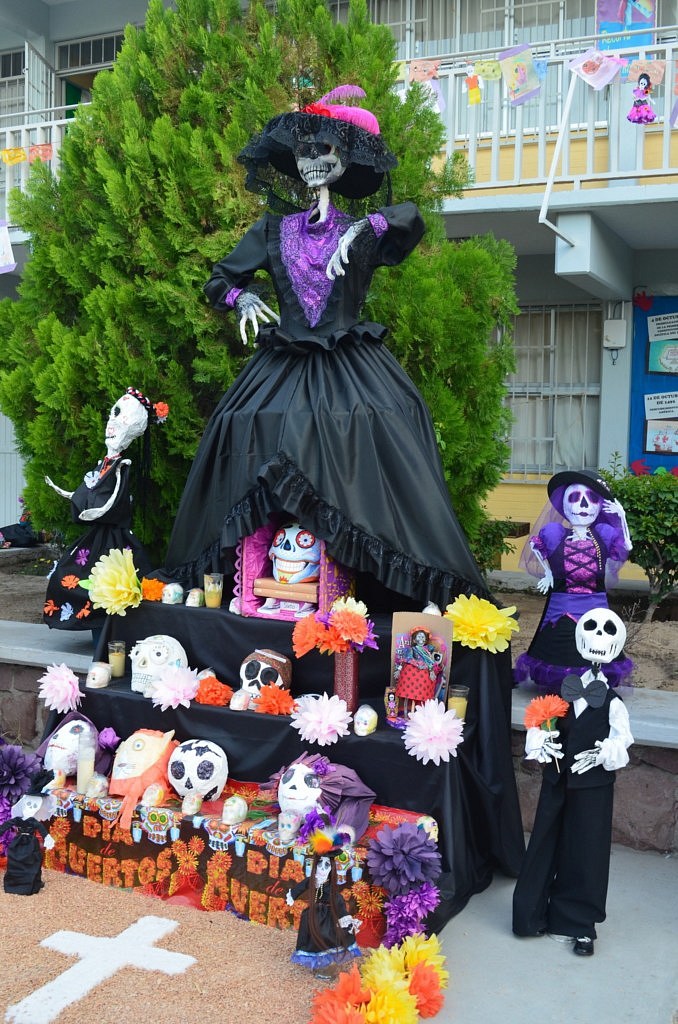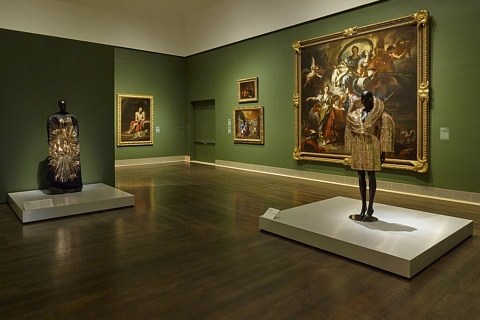It is early in the morning and the windows are closed, but you can still hear the wind outside. The smell is strong, but pleasant; it’s one that only comes once a year, that of cempasúchil—the Mexican marigold. Colorful hand-cut banners with skulls, flowers, hearts and catrinas designs hang all over. Family or celebrity photos are also included. Let’s not forget the sugar skulls, the candles and the bread. Fruits, favorite dishes and gifts are also part of the picture.
Altar to Freida Kahlo set up with Mexican marigolds, Cempasúchil / Photo by Rosa Irene Aranda | Cooglife
Everything is set up for the Day of the Dead.
If you think Day of the Dead is a Halloween after-party or another day to catch up on trick-or-treating, you have got it all and completely wrong. But it is OK; today you can learn what it really is.
Day of the Dead is a joyous, folklore party in which the living and the dead are joined; it is believed the dead visit the living world one more time on this day to reunite with loved ones.
Commemorated every Nov. 2 in Mexico, and at some other dates in other parts of the world, the Day of the Dead is a major day that is everything except scary or eerie.
In Mexico, its origins date back hundreds of years before pre-colonial times, when some indigenous groups celebrated the deaths of ancestors with rituals in the Mesoamerican region, center and south of the country. Nowadays, it is the mix of indigenous heritage and Catholicism.
Day of the Dead was recognized as Intangible Cultural Heritage of Humanity by UNESCO in 2003, and it is a national holiday in Mexico.
So, what exactly do people do on this day? Cry? No. Yes. Maybe. Depends.
Although mourning a deceased could happen, it is not the main purpose. This day is about honoring, praying and cherishing the moments lived with the ones who already left this world. It is all about happy moments.
This happens in a crafty, picturesque, caring and traditional way. However, it is important to note that while traditions vary from region to region, estate to estate and family to family, they share more similarities than differences.
Altars of all sizes are built with all possible offerings, like dishes of their favorite meals, their favorite drink—beer, soda, tequila, mescal, or whatever they liked—their favorite candies, sugar skulls, enlightened candles and sometimes religious symbols, like crosses and images of Virgin Mary, which were incorporated post-colonialism.
There are also other offerings, which are more symbolic and representative of this day: papel picado, dead bread, flowers, pictures of the deceased and water.
Papel picado, or perforated paper, is a Mexican folk art whose skeleton and skull designs are cut from tissue paper. Dead bread, known as pan de muerto, is a traditional Mexican sweet bread, which is produced every year solely for this occasion. The structure of the bread is very significant. The top, the ball, represents a skull and shins are the bones whose shape symbolizes the four directions of the universe.
The Mexican marigold, Cempasúchil, which is also called “flower of the death,” symbolizes the glare of the sun and is believed to guide souls to where their homes were; each flower represents life and that the dead have not been forgotten by family and friends. The portrait of the remembered persons suggest their spirits will visit on the Day of the Dead.
Last, but not least, water, which reflects the purity of the soul and also serves to help the spirit mitigate their thirst after their trip from the world of the dead.
There are indeed more offerings that could be included in an altar. Toys for the spirits of children, who unlike the adults, are believed to visit the living world on Nov. 1.
Some people visit cemeteries and decorate the graves of loved ones with candles, flowers, pictures, play their favorite music or bring Mariachi to rejoice the moment. Some others decide to set aside space in the house to construct an altar, making it a more private celebration.
Either way, people choose to never forget, praise and dedicate a day solely to their memories because, though they might be gone from this world, loved ones will never be gone from the hearts of the people who love and miss them every single day.






Recent Comments